Basement Flooding Preparedness

For more information
Call 905-546-2489 or
Email [email protected]
For a water or wastewater emergency
Call 905-546-2489

City Flooding Assistance Programs
The City of Hamilton offers property owners of single-family residential homes a grant and or loan of up to $2000 each for eligible works that help to reduce the risk of basement flooding.
Rain storms are becoming more frequent and more intense. Basement flooding can cause serious damage, as well as personal and financial hardships. Where the water comes from will help identify the type of flooding, and how to address it.
A basement floor drains or basement fixtures? This is a sewer back-up.
When major weather events overwhelm the City’s sewer system it can result in flooding. When this happens the water level in the system rises above the normal design levels, this is referred to as a sewer surcharge. Sewer back-ups can also occur when the homes sewer lateral (pipe running from your home to the sewer main) becomes blocked or damaged and the homes wastewater can no longer make it to the City’s sewer mains.
Through a basement window? This is overland flooding.
When water flows overland, it may enter basements through windows, doors, vents and other openings. This could be due to improper grading, exposed window wells, an extreme wet weather condition that exceeds the capacity of overland routes or underground pipes.
Through a basement wall? This is infiltration flooding.
When soil around your home becomes saturated or when the ground water level rises higher than your basement, water will get into your basement through cracks in the foundation walls and floor.
Please call the City of Hamilton 905-546-2489 to report if you are experiencing water or sewage coming up a floor drain or other basement fixtures in your home. You may be asked a few simple questions to help determine the nature of the problem and will be given information if there are programs (listed below) for you to take advantage of.
Over the past five years Hamilton has experienced a lot of rain. The rain storms last longer, are more intense and occur more frequency than in previous years. The City of Hamilton is committed to assessing, analyzing and implementing storm water management improvements to deal with heavy rain.
For more information and useful tips to adapt to urban run-off, please visit Green Venture.
Potential Causes of Flooding
During heavy rainfall, the water from the roof eavestroughs that are connected to the weeping tile through the downspouts may cause weeping tiles to become overwhelmed. If your weeping tiles are connected to the sanitary pipes, this may cause rainwater or sewage to back up in your home.
Solution: Disconnect weeping tiles and downspouts from the sanitary sewer system.
Have a qualified plumber investigate disconnecting your weeping tiles and downspouts from the sanitary sewer system.

If your home has a sump pump, it may have malfunctioned. This could cause your basement to flood.
Solution: Replace your sump pump
Make sure you maintain your sump pump properly. If your sump pump stopped working in the past, contact a qualified plumber to replace it. It is common for homes to lose power during severe storms, which can affect sump pump operation. Install a battery backup on your sump pump to avoid this.
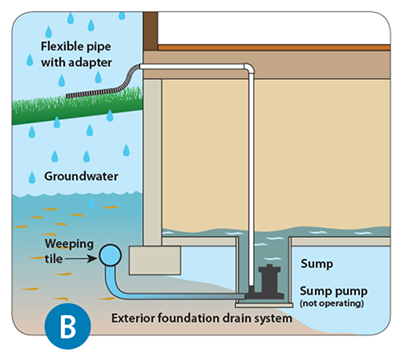
Basement flooding can occur when the ground is saturated around the foundation walls or when weeping tiles are not working properly.
Solution: Smart landscaping
- Check that the ground around your house slopes away from your foundation. This helps keep water from entering through cracks in your foundation or overloading the weeping tiles. View more information about lot grading and drainage.
- Direct your downspouts away from the home where water can be easily absorbed, such as your lawn or garden.
- Connect the downspout to a rain barrel and direct the overflow hose towards your lawn or garden, not onto your neighbour’s property.
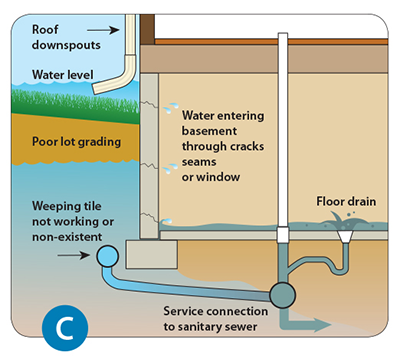
Sewage can back up into the basement if the City’s sanitary sewer pipe is full due to large amounts of water.
Solution: Flood proofing devices
Homes prone to flooding may benefit from plumbing improvements. These include:
- Backwater valve
- Sewer lateral repairs
- Installations of sump pits and pumps
- Downspout disconnection
Consult a professional before doing any work. Check to see if you are eligible for the City’s Protective Plumbing Grant Program or Loan Program.
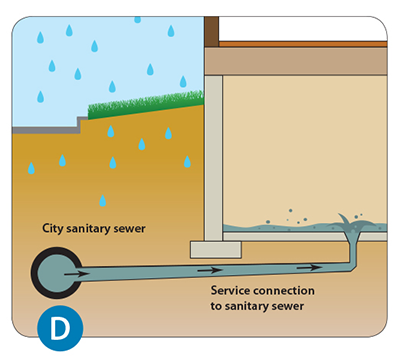
In the City of Hamilton, the entire sewer lateral from house/building to main sewer connection is a private asset, owned by the property owner. Sewer back-ups/flooding in the basement can occur due to issues with the private sewer pipe from:
- Tree roots have infiltrated the sewer lateral through a crack or separated joint from a private or City tree
- Shifting clay pipes over time causing displaced joints and fractures
- Calcite buildup at displaced pipe joints due to ground water infiltration
- Cross boring in the sewer lateral from a utility company; Union Gas, T.V. cable, Hydro and Bell telecommunication’s
- Fence post installation
- Hydro or light pole installation & guide wires
- Heavy digging in the front yard, landscaping and or driveway installation
- Sag or belly in sewer lateral
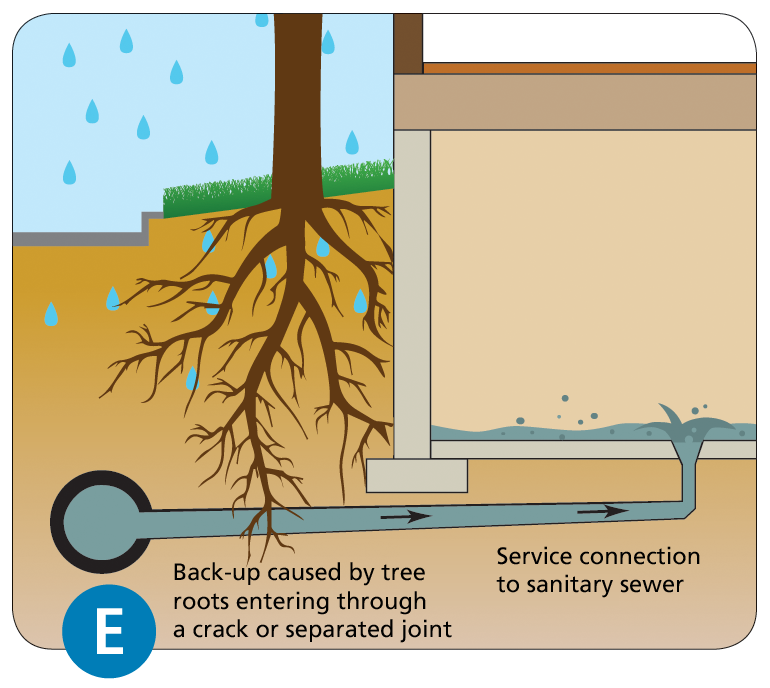
Solution: Homes that experience a sewer lateral (pipe) back up should consider having their entire sewer lateral investigated using a private plumber or City contractor. Learn more about the City of Hamilton's Sewer Lateral Management Program.
Flooding Prevention Tips
Here are things you can do throughout the year to prevent or minimize flooding and associated damage.
- Ensure your sewer laterals, the pipes from your house to the sewage line, are functioning properly.
- Seal cracks in your basement floor and foundation walls.
- Keep your eavestroughs clean so they can direct water away from your house. When they are not maintained, rainwater is more likely to enter your home through cracks in your foundation.
- Minimize points of entry for overland flooding such as window wells and window well covers.
- When landscaping, ensure the grade of your lot flows away from your home.
- Use permeable surfaces for driveways and walkways so that water can soak into the ground.
- Ensure catch basins on the road near your property are clean. Keep leaves and yard waste from piling up in the roadway, ditches and sidewalks. They can clog the sewer system.
- Do not store items on the floor in your basement. Install shelves several feet off the floor to store items.
- Do not sit appliances, furnaces and water heaters directly on the floor in your basement. If possible, they should be set on a stable platform or on appropriate material such as cement blocks.
- Install electrical outlets and electrical panels higher than a projected flood level.
- Do not run drywall all the way to the floor in a finished basement; use material such as tile or linoleum running up the wall about one foot high to guard against water damage.
- Consider protective plumbing options such as backwater valves, sump pumps, and downspout disconnections.
- Do not pour grease down the sink and into the sewer system. The grease may stick to the sides of your sewer pipe or the City’s sewer pipe. Over time, this could build up and create blockages.
- Consider disconnecting downspouts from the sewer system. Make sure neighbouring properties will not be adversely affected.
- Maintain the swale on your property. The swale is usually located on the property line between properties. A swale is a shallow trough-like depression that carries water during rainstorms or snow melts.
- Create an inventory of your possessions with photographic and/or video documentation in case you need to submit an insurance claim for water damage.
Here are things you can do in the spring and summer to prevent or minimize flooding and associated damage.
- Make sure the grading allows water to flow away from your home when landscaping your property.
- Minimize the amount of hard surface such as cement, driveways and walkways on your property. Rainfall should be absorbed into the ground. Hard surfaces make the water flow in the most natural direction.
- Plant gardens, plant material and trees to absorb water.
- Use rain barrels to direct water away from your home and the sewer system. Set up your barrel so rain from your eavestrough goes into it. Run a hose from the rain barrel to water your garden.
- Install window well covers to keep window wells free from debris, which can clog drains and cause basement flooding.
Here are things you can do in the fall to prevent or minimize flooding and associated damage.
- Clean up leaves and yard waste from the roadway, ditches or sidewalks. This prevents clogged catch basins and allows the free flow of water. You can put out an unlimited amount of yard waste on your pick up day every week.
- Clean up litter to prevent blockages in the sewer system.
- If you see larger debris on the street, call 905-546-2489 to have it removed.
- Clear leaves from your eavestroughs. When your eavestroughs are blocked, the rain will pour over the edges landing on the ground next to your home. If you have cracks in the cement wall of your basement or problems with your weeping tile, this water could enter your home.
Here are things you can do in the winter to prevent or minimize flooding and associated damage.
- Keep catch basins clear and uncover fire hydrants near your home.
- When clearing your driveway, move snow toward the side of your property that the plow finishes with so less snow accumulates across the driveway when the plow passes.
Many homes in Hamilton have a sump pump installed. The sump pump plays an important role in flood prevention and keeping water out of your basement. A sump pump is typically a small pump used to help keep the area under your home dry and to prevent it from flooding by removing excess water that has accumulated. The sump basin which should be in the lowest part of your basement or crawlspace is where the unwanted or excess water collects.
When the water level gets too high the sump pump is activated and begins pumping water out of the basin. The water is pumped outside and away from your home, so the basement stays dry. It is important to maintain and test your sump pump on a regular basis to ensure that it will work properly when needed.
Testing
To ensure the pump is working properly perform this three-step test:
- Check to make sure that there is power running to the sump pump.
- Pour enough water into the sump pit for the pump to begin working.
- Check the outside pipe to ensure that water is flowing from the discharge line outside your home and away from your foundation, as well as, your neighbour’s foundation.
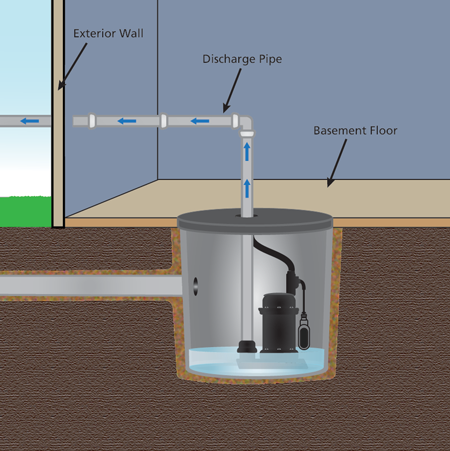
Maintenance
Sump pumps have a lifespan of approximately 10 years, which can vary based on how often it is working, the quality of the water (dirt and grit) and the quality of the pump itself. Different manufacturers have different recommendations for testing and maintaining your sump pump. Please follow the recommendations provided by the manufacturer. There are some steps that you can do to help your sump pump run effectively. If your pump is operating during freezing weather, it is best to disconnect outside hoses prior to winter. This will help blockages from forming in the hose which could damage the sump pump. Always make sure that the water discharges away from your home. If water from your sump hose discharges too close to your foundation, the water may end up back in your system.
*Maintenance should be done by a qualified technician.
City Flooding Assistance Programs
The Protective Plumbing Program is part of the City’s strategy to help residential property owners mitigate basement flooding. There are programs to help reduce the risk of basement flooding with the installation of backwater valves, sump pumps and downspout disconnections.
Protective Plumbing Grant Program
The City of Hamilton offers property owners of single-family residential homes a grant (subsidy) of up to $2000 for the installation of a backwater valve and other eligible works that help to reduce the risk of basement flooding.
Learn more about the Protective Plumbing Grant Program
Protective Plumbing Loan Program
In addition to the grant program the City offers a loan program to assist with eligible work costs that help reduce the risk of basement flooding.
Learn more about the Protective Plumbing Loan Program
Sewer Lateral Management Program – Sewer Back-up
Your wastewater is carried to the City’s main sewer by a privately-owned pipe, called a sewer lateral. You own this pipe all the way to where it connects with the City’s Main sewer in the street.
The City of Hamilton offers a Sewer Lateral Management Program to provide technical and financial assistance to property owners. Where eligible this includes:
-
24-hour clearing and inspection of the sewer lateral
-
rehabilitation or replacement of the public portion of the sewer lateral (located in the public right-of-way, from the property line to the main sewer)
-
Financial assistance (Grant) for rehabilitation or replacement of the private portion of the sewer lateral (located on private property from the building to the property line).
